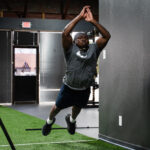Maximize Results with Smart Sports Training
Sports training plays a vital role in helping athletes reach their full potential. Whether you’re a beginner or a pro, structured sports training is the key to consistent performance gains. In this article, you’ll learn smart training techniques to boost results, improve movement, and reduce injury risks.
Why Sports Training Matters
Effective sports training goes beyond regular exercise. It’s about developing speed, power, agility, and endurance in a way that’s sport-specific. A good sports training plan can help athletes outperform the competition. It also ensures the body stays strong, resilient, and balanced.
When you train with a goal in mind, every workout becomes purposeful. This focus helps you track progress and stay motivated. As a result, athletes benefit from faster development and better game-day performance.
Components of a Great Sports Training Program
Smart sports training includes more than just lifting weights or running sprints. It combines several elements:
- Dynamic warm-ups: Prepares the muscles and joints
- Plyometrics: Builds explosive power
- Strength training: Increases force production
- Speed drills: Improves quickness and reaction time
- Agility work: Enhances change-of-direction skills
- Recovery: Promotes growth and prevents burnout
Each of these elements plays a unique role. Together, they help athletes develop as complete performers.
Avoiding Injuries Through Smart Sports Training
Many athletes get injured due to poor training habits. Overtraining or skipping warm-ups are common causes. With smart sports training, you can reduce these risks.
A well-rounded program includes recovery periods, movement assessments, and mobility work. These strategies help identify weaknesses before they become injuries. For example, strengthening the glutes can help prevent knee pain. Including balance exercises can reduce ankle sprains.
Another key point is rest. Your body needs time to adapt and grow stronger. Therefore, rest days are not a waste—they’re part of the plan.
How to Customize Your Sports Training
There is no one-size-fits-all program. The best sports training plans are tailored to each athlete’s needs. Consider your age, sport, goals, and current fitness level.
If you’re in-season, focus on maintaining performance. Off-season? It’s time to build strength and fix imbalances. Every phase has a purpose, and each should include appropriate progressions.
At Next Level Athletics, athletes receive personalized training that matches their sport and goals. This approach ensures they make steady progress while avoiding overuse injuries.
The Role of Coaching in Sports Training
Great coaches make a big difference in sports training. They create plans, adjust for weaknesses, and provide motivation. Coaches also teach proper form and correct mistakes early.
Feedback from a coach keeps you on the right path. They see things you may miss and help fine-tune performance. This constant guidance often separates good athletes from great ones.
Look for coaches who stay updated on research and methods. According to the NSCA, continuing education is a sign of a professional who values athlete safety and development.
Final Thoughts: The Smarter Way to Train
Sports training should be both strategic and adaptable. It’s not just about working harder—it’s about working smarter. Build your program around your goals, include recovery, and don’t skip the small stuff like mobility and balance.
With the right approach, sports training can unlock new levels of performance. Combine science-backed methods, expert coaching, and consistent effort for the best results.
Start training smarter today and take your game to the next level!


Recent Comments